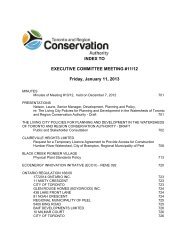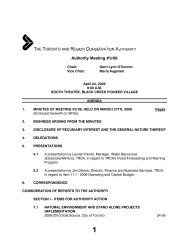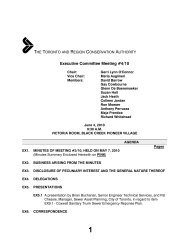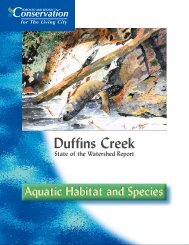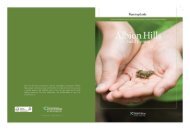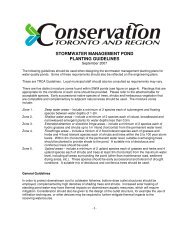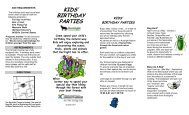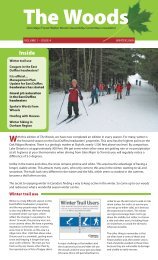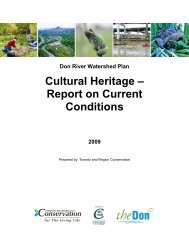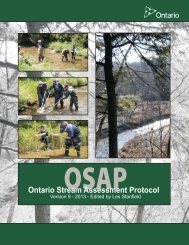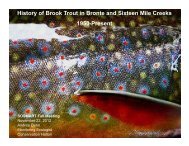Aquatic System - Toronto and Region Conservation Authority
Aquatic System - Toronto and Region Conservation Authority
Aquatic System - Toronto and Region Conservation Authority
You also want an ePaper? Increase the reach of your titles
YUMPU automatically turns print PDFs into web optimized ePapers that Google loves.
order coldwater tributaries that appear to have local groundwater sources (KatabokokonkCreek <strong>and</strong> unnamed tributary that both flow into the main branch of the Little Rouge).The groundwater model suggests that approximately 2/3 of groundwater discharge enters thesystem via small, low order streams (see Chapter 4 Groundwater). When integrated with thefisheries data, it is in these small streams that healthy populations of brook trout <strong>and</strong> redsidedace are predominately found. Challenges to maintaining existing groundwater flow regimesmay increase for streams reliant on local recharge/discharge as these areas are within theurbanizing boundary. Unless mitigated, the change in impervious cover during development inthis area of recharge may result in flow loss to these streams. Two figures illustrate thewatershed areas that are predicted to have high groundwater discharge (>2.5 L/s) based ongeology (Figure 8-1) <strong>and</strong> whether that groundwater is sourced locally (short tracks) orregionally (long tracks) (Figure 8-2). It is noted that the fisheries data <strong>and</strong> field knowledge oflocal stream habitat supports the groundwater model results.8.3 Measuring <strong>and</strong> Evaluating the <strong>Aquatic</strong> <strong>System</strong>There are two types of measurements taken to evaluate the aquatic system: biotic <strong>and</strong> abiotic.biotic measures refer to living organisms, both plant <strong>and</strong> animal. Species numbers, distribution<strong>and</strong> community structure can provide a good measure of environmental condition at the localsite level <strong>and</strong>, in some cases, over a larger region. Abiotic measures refer to physical orchemical factors that respond to environmental change. For example, other chapters havediscussed how human l<strong>and</strong> use change has altered watersheds by modifying channelstructure, altering baseflows, increasing the volume <strong>and</strong> frequency of runoff <strong>and</strong> peak flows,chemical contamination of ground <strong>and</strong> surface water, erosion <strong>and</strong> sediment loading <strong>and</strong>altering water temperature.Having identified the two categories of measures, the decision around which of the many biotic<strong>and</strong> abiotic metrics are chosen for an evaluation is fundamental to a meaningful analysis. Withthat, pinpointing thresholds at which ecological integrity is put at risk due to l<strong>and</strong>scape changeis a difficult procedure owing to the synergistic effects of changes to water quality, quantity,riparian vegetation, temperature, human use, <strong>and</strong> a host of other factors. By convention,knowledge of the natural physiographic setting coupled with indices that examine speciessensitivity to physical in-stream parameters (e.g. Fish <strong>and</strong> Invertebrate Indices of Biotic Integrityor other measures (e.g. stream thermal stability, baseflow <strong>and</strong> surface flows) have been usedto assess the aquatic system. While useful, there is still interpretation associated with thesetechniques <strong>and</strong> growing evidence that the current application (as a metric) of these commonlyused indices/measures may not be appropriate at large spatial scales or within the context ofan urbanized watershed. That is, the context <strong>and</strong>/or purpose for which some indices wereoriginally developed may not transfer well to measuring the impacts of change to thel<strong>and</strong>scape. Metrics that arguably have interpretive limitations will be identified <strong>and</strong> discussed inthe following section.8-3



